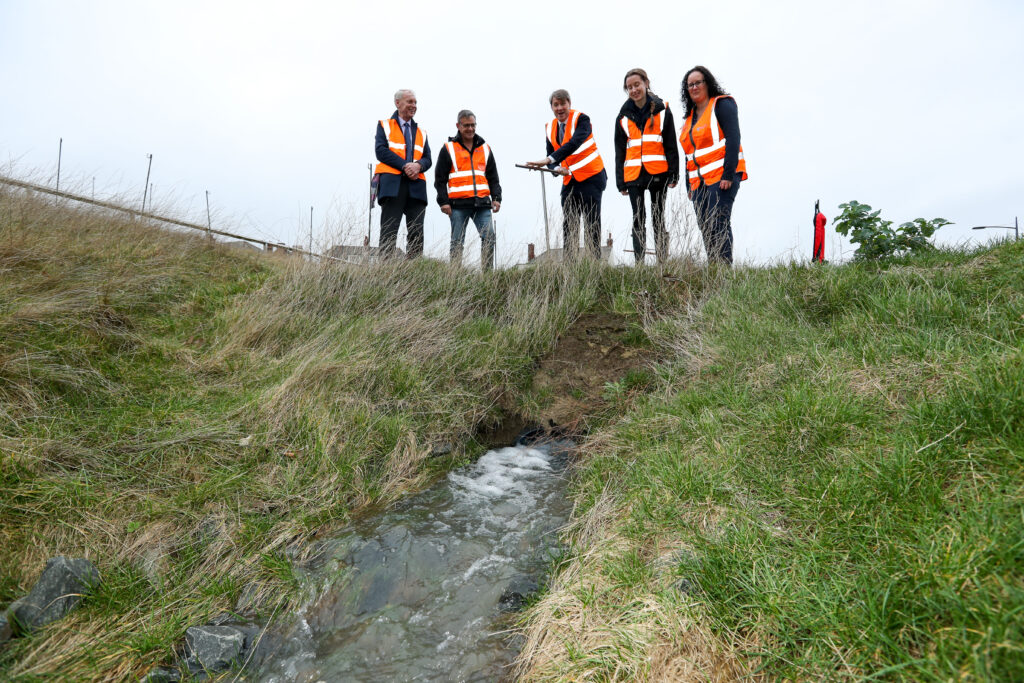Living laboratory for sustainable drainage systems


This new facility at Newcastle University will put the UK at the forefront of innovation in flood defences, helping us reduce the damage we have seen too often across the country.”
The Rt Hon Chris Skidmore
Minister of State for Universities, Science, Research and Innovation
Sustainable drainage systems are needed to give our cities a method to reduce the risk of floods.
The UK’s largest testbed for sustainable drainage systems is providing a blueprint for how our cities should be designed in the future, to reduce the risk of flooding.
Situated in the heart of Newcastle, the swale is fitted with a network of sensors and cameras to monitor flow, water levels, soil moisture, rainfall and other meteorological conditions.
This data is then fed into Newcastle University’s Urban Observatory, the UK’s largest set of real-time open data, and will be used to inform future flood management and help policy makers and emergency services make decisions in real time if, and when, flooding occurs in the future.

The Rt Hon Chris Skidmore, Minister of State for Universities, Science, Research and Innovation Tomorrow launches the UK’s National Green Infrastructure Facility at Newcastle University. A testbed for sustainable drainage and a blueprint for how our cities should be designed in the future in order to reduce the risk of flooding in the face of climate change. Based on Helix, the facility – which includes a full-scale swale with ‘leaky barriers’ will be turned on tomorrow to test floodwaters equivalent to those experienced during Thunder Thursday and demonstrate how systems like this can be used to protect cities across the UK from flash flooding. Photo: John Millard/Newcastle University
Based on the Newcastle Helix site – a 24 acre ‘living laboratory’ and innovation hub – the Facility is the latest addition to Newcastle’s Blue-Green City initiative.
Launching the project, Mr Skidmore said, “This new facility at Newcastle University will put the UK at the forefront of innovation in flood defences, helping us reduce the damage we have seen too often across the country.
“Our approach to climate change must not just be reducing emissions, but also to tackle its impacts like milder, wetter winters and rising sea levels, so we can save our planet and protect it for future generations.”
Solving the problem
Co-director of the National Green Infrastructure Facility (NGIF) Dr Claire Walsh, a lecturer in Green Infrastructure at Newcastle University, said the aim was to use this site as a demonstrator to help protect other urban areas from flooding.
“The UK has seen an increase in the number of extreme weather events over the past decade and we have seen the devastation and distress that flash flooding causes.
“Naturally-engineered schemes should work hand in hand with flood defences. In this way, we can disperse the water and reduce the flood risk rather than simply moving the problem downstream.
“At Newcastle University, we are working on designing a number of natural flood management schemes to help our urban environment cope with a changing climate and future development pressures.”
Co-director Dr Ross Stirling, a lecturer in Geotechnical Engineering at Newcastle University, added:
“Through the NGIF, we are not only considering the benefit that ‘green infrastructure’ can provide in terms of reducing flood risk, but also looking at its economic, social and environmental benefits.
“We are exploring how green spaces may be exploited for renewable heat generation, adding value beyond their role in surface water management. We are investigating the treatment of polluted runoff from our streets and the carbon capture potential of green infrastructure. And we are considering how these approaches compare with traditional methods such as pipes by evaluating the cost of constructing these features and maintenance regimes over time.
“Flooding can be extremely costly from both an economical and emotional perspective and investment in mitigating floods upfront using green infrastructure can bring a wide range of benefits.”
Photos by: John Millard/Newcastle University
Partners
Similar stories
Northumbrian Water: Interruption to Supply Risk Mapping using Spatial R Package
Jumping Rivers has worked with Northumbrian Water to develop a tool that identifies the risk of interruption to water supply.
Empowering patients and professionals with transformative technology
A renowned life science enterprise and Monstarlab worked to develop an innovation funnel for the company’s digital app services.
Strengthening data analyst skills to optimise battery systems
Embedding new data science skills into their organisation Working with NICD, Connected Energy...
PYRAMID real-time platform for flood risk assessment
Developing a digitally-enabled environment which benefits policymakers, businesses, communities and individuals
Connected homes as living labs for energy management technologies
55 homes in Newcastle have been fitted with equipment to become living labs for the energy sector.
Helping communities use sensors to solve local issues
SenseMyStreet is a toolkit that enables local communities to commission sensors that collect environmental data about their street.









